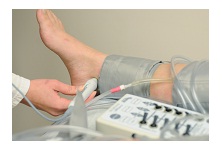This test is done by measuring blood pressure at the ankle and in the arm while a person is at rest. Measurements are usually repeated at both sites after 5 minutes of walking on a treadmill. The ankle-brachial index (ABI) result is used to predict the severity of peripheral arterial disease (PAD) of the legs. It is also used to see how well a treatment is working (such as medical treatment, an exercise program, angioplasty, or surgery).
Preparing for the Test
Patients may want to wear loose, comfortable clothing that allows the technician performing the ankle-brachial index test to easily place a blood pressure cuff on the ankle and upper arm.
 During the Test
During the Test
Patients will lie on a table on their back, and a technician measures blood pressure in both arms using an inflatable cuff. The technician then measures the blood pressure in two arteries in the left ankle using the inflatable cuff and a hand-held Doppler ultrasound device that the doctor will press on the skin. The Doppler device uses sound waves to produce images and lets the doctor hear the pulse in the ankle arteries after the cuff is deflated.
The procedure for performing an ankle-brachial index test may vary slightly, based on each doctor’s preference. Having an ankle-brachial index test is painless and similar to having blood pressure taken in a routine visit. Patients may feel some pressure on their arm or ankle when the cuff inflates to read the blood pressure.
 After the Test
After the Test
The ankle-brachial index test should take only a few minutes, and there are no special precautions to take following the test.
Results
A lower ABI means you might have peripheral arterial disease (PAD). A slight drop in the ABI with exercise, even if you have a normal ABI at rest, means that you probably have PAD. This drop may be important, as PAD can be linked to a higher risk of heart attack or stroke.
A normal resting ankle-brachial index is 1.0 to 1.4. This means that the blood pressure at the ankle is the same or greater than the pressure at the arm, and suggests that the patient does not have significant narrowing or blockage of blood flow. An abnormal resting ankle-brachial index is 0.9 or lower. If the ABI is 0.91 to 0.99, it is considered borderline abnormal. A very abnormal ABI test result may require more testing to determine the location and severity of PAD that might be present.
To read more about ABI, please click on the following links:
http://www.webmd.com/heart-disease/ankle-brachial-index-test
http://www.mayoclinic.com/health/ankle-brachial-index/MY00074
